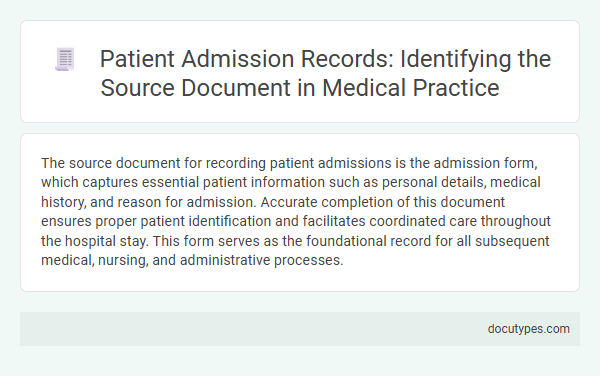The source document for recording patient admissions is the admission form, which captures essential patient information such as personal details, medical history, and reason for admission. Accurate completion of this document ensures proper patient identification and facilitates coordinated care throughout the hospital stay. This form serves as the foundational record for all subsequent medical, nursing, and administrative processes.
Introduction to Patient Admission Records
| Introduction to Patient Admission Records | |
|---|---|
| Definition | Patient admission records are official documents used to capture essential information when a patient is admitted to a healthcare facility. |
| Source Document Purpose | The source document for recording patient admissions serves as the primary legal and medical record detailing patient demographics, medical history, reason for admission, and initial clinical assessment. |
| Key Components |
|
| Importance in Clinical Practice | The admission record forms the foundation for patient care planning, continuity of care, billing, and legal documentation. It ensures accurate communication among multidisciplinary teams. |
| Common Formats | Source documents may be paper-based admission forms, electronic health record (EHR) admission templates, or standardized admission checklists consistent with hospital policies. |
| Regulatory Compliance | Accurate admission records comply with healthcare regulations such as HIPAA and Joint Commission standards, protecting patient privacy and maintaining record integrity. |
Importance of Source Documents in Medical Practice
The source document for recording patient admissions is the initial clinical record or admission form completed at the time of patient entry into a healthcare facility. This document provides a foundational record for patient care, ensuring accurate and comprehensive information is captured for all subsequent medical processes.
- Accurate Patient Identification - Ensures precise tracking and reduces medical errors by establishing the patient's identity at admission.
- Legal Documentation - Serves as an official record that supports compliance with healthcare regulations and legal requirements.
- Continuity of Care - Facilitates effective communication among healthcare providers by providing essential patient history and admission details.
Source documents are critical for maintaining the integrity and reliability of patient medical records throughout their treatment journey.
Definition and Purpose of Patient Admission Records
What is the source document for recording patient admissions? The source document for recording patient admissions is the Patient Admission Record, a critical component in medical documentation. This record serves as the official account of a patient's initial entry into a healthcare facility, capturing essential demographic, medical, and administrative information that ensures accurate and efficient patient management.
Components of Patient Admission Records
The source document for recording patient admissions is the patient admission record, a critical component of medical documentation. It includes essential information such as personal identification, medical history, reason for admission, and consent forms. Your accurate and thorough input ensures comprehensive patient care and effective communication within the healthcare team.
Role of Source Documents in Patient Admission
The source document for recording patient admissions is typically the admission form or electronic health record (EHR) input at the time of arrival. These documents serve as the primary reference for capturing accurate patient information, including personal details, medical history, and initial assessments. Your healthcare providers rely on these source documents to ensure seamless communication and continuity of care throughout the patient's stay.
Identifying Authentic Admission Source Documents
The source document for recording patient admissions is typically the admission form or electronic health record (EHR) entry created at the time of patient intake. This document serves as the original record capturing essential patient information, admission date, time, and reason for visit.
Authentic admission source documents include signed consent forms, physician's admission notes, and verified registration details. These documents ensure accuracy and legitimacy in the patient admission process, maintaining compliance with healthcare regulations and facilitating effective patient care management.
Common Types of Source Documents in Admission
The source document for recording patient admissions is the initial medical record that captures essential patient information upon entry to a healthcare facility. This document serves as the foundation for accurate and comprehensive admission data entry.
Common types of source documents in admission include the admission form, which details personal and insurance information, and the physician's admission note, documenting clinical observations and preliminary diagnoses. Other important documents are consent forms and referral letters, which support the admission process by providing legal and medical context.
Challenges in Source Document Verification
The source document for recording patient admissions is the initial admission form or electronic health record entry that captures patient information at the point of care. Accurate verification of this document is critical to ensure patient safety and legal compliance.
Challenges in source document verification often arise due to inconsistent data entries, incomplete information, and discrepancies between multiple data sources during admission.
- Data Inconsistency - Variability in handwriting, terminology, or electronic input can lead to mismatches in patient data, complicating verification.
- Incomplete Documentation - Missing vital patient details affect the ability to corroborate admission records promptly and accurately.
- Source Discrepancies - Conflicting information from different admission forms or systems requires thorough cross-checking to resolve.
Best Practices for Managing Admission Source Documents
The source document for recording patient admissions is the initial admission form or electronic health record entry completed at the point of care. Accurate management of these documents is critical to ensuring reliable patient data and streamlined care coordination.
Best practices for managing admission source documents include strict verification, secure storage, and timely updating of patient information.
- Verification of Patient Information - Confirm patient identity and admission details immediately to prevent errors.
- Secure Document Storage - Maintain physical or digital documents in compliance with HIPAA and local regulations to protect patient privacy.
- Timely Data Updates - Update admission records promptly when new information arises to support clinical decision-making.
What Is the Source Document for Recording Patient Admissions? Infographic

